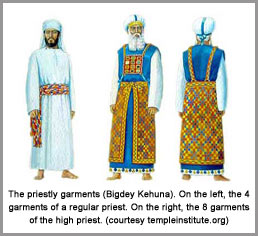 Iran’s Attack on Israel
Iran’s Attack on Israel


13 min read
What to wear and what not to wear. From Moses, not Paris.
Is it necessary to be properly dressed in the privacy of one's own home? How about in the bedroom? How about in the bathroom? Why does halacha have stricter standards for women's dress than for men? Why must a married woman keep her hair covered while an unmarried woman is exempt?
To answer these questions, let's try to understand the foundations of the Jewish concept of tzniut.2
The Torah requires that when a Jewish soldier goes to war, he must take along a shovel.3 Is it to dig trenches along the battlefield? Not at all. The Torah requires a shovel so that when one relieves himself on the battlefield, he will be able to cover up the waste. Anything less is considered undignified.
If there is ever a time when people are not concerned with dignity, it is during battle. Warfare arouses all sorts of animalistic drives – attacking, killing, pillaging, plundering. Yet the Torah teaches us that even under such circumstances, a Jew must maintain his dignity. And all the more so under other circumstances!
A human being is created in the image of God. Our behavior should always reflect the Godliness within us. This does not mean we can never joke around and have fun. But we should maintain dignity in whatever we do, remembering that the Divine Presence is everywhere.
This does not mean that one's dress and behavior must be the same in all places. Rather, attire and conduct should be appropriate to uphold your sense of self-respect and self-esteem.
There are certain minimum standards of tzniut. Most of these are to women, since women have a natural inclination toward dignity and privacy. In general, women should not behave in a way that unduly attracts attention. They should not wear loud colors, and should avoid fashions that emphasize their bodies. If a woman wants to be respected for her spiritual-intellectual side, she should not be focusing undo attention to her body. This is how a woman can maintain the respect of others, and elevate her own sense of self-worth.
When in front of men, a woman must cover the:
Married women are also required to have their hair covered when leaving the house.6
What role do social standards play in determining one's dress and behavior? The Talmud7 refers to Da'at Yehudit (also pronounced Da'as Yehudis), which is loosely translated as Jewish consciousness. This principle dictates that a Jewish community determines a minimum set of standards for dress and behavior. Of course, one may choose to behave in a fashion that is more dignified, but not less so.
The Talmud8 tells of a woman who was told by astrologers that her young son was destined to be a thief. In an effort to avert the predicted fate, she made sure that her child wore a head covering at all times, so that the "fear of Heaven" would always be upon him.
Every Jewish man must keep his head covered.9 This applies even to young boys.10 Most parents try to keep their sons' heads covered from the age of three.
The traditional head covering is called kippah in Hebrew (literally "dome"), and yarmulke in Yiddish (based on an Aramaic expression meaning, "awe of the King"). A man's head covering must be large enough to be seen from all sides.11 Certainly, any type of hat qualifies for this.
(View a slideshow of various kippot.)
One is not obligated to lose his job over the need to keep his head covered.12 Fortunately, almost all Western countries have strict laws forbidding discrimination due to religious beliefs. One need not feel self-conscious about wearing a symbol of religious belief. In almost all cases, you will get more respect from your employer, colleagues and clients – as they admire a person who stands up for his convictions.
For many seeking to express their Jewish identity, "to kippah or not to kippah?" – that is the question. Here are two fascinating first-person accounts dealing with this issue:
When showering or swimming, a man need not keep his head covered.13
A man is not obligated to cover his head while sleeping, but it is considered praiseworthy to do so.14
A man is forbidden to pray, recite blessings or study Torah while bareheaded.15 Putting one's bare hand or arm on his head does not qualify as a head covering.16 However, one may cover his head with a sleeve.17
A bareheaded man may respond "amen" to someone else's blessing.18
After their sin, God made clothing for Adam and Eve. They treasured these special sets of clothing and preserved them for future generations.19 Indeed, Jews have always given special respect to clothing. The Midrash says that one of the key merits by which the Jews were redeemed from slavery in Egypt is that they maintained a distinctive "Jewish style" of dress. The kohanim in the Holy Temple were required to wear special clothing while performing the service.20 King David was punished for having demonstrated minute irreverence toward clothing by snipping a corner off King Saul's garment.21

A Jew must always be careful to dress in a dignified manner.22 In fact, it is forbidden for a Torah scholar to wear a stained garment.23
One should get dressed with dignity, even if there is no one else around, since the Almighty's presence is everywhere.24
In kabbalistic literature, we are warned not to don two articles of clothing simultaneously.25However, there is no problem with taking off multiple articles of clothing at the same time.26
The Torah generally gives precedence to the right over the left in everything that we do. In kabbalah, the right side represents kindness, while the left is strictness. We always strive to emphasize the kindness, though tempered with discipline.
When putting on any articles of clothing, the right side should be put on first.27 This applies even to left-handed people.28
One exception is articles that involve any form of tying: there the Torah prefers the left to the right (for men), as every right-handed man binds the tefillin on his left arm. Similarly, a man should tie his left shoe before the right one.29 A left-handed man may tie either shoe first.30 Fastening buckles and Velcro is not considered tying, so the right side should always be done first.31
Since women do not wear tefillin, they tie the right shoe first.32
When a man removes his shoes, he should both untie and remove his left shoe first.33 (Keeping the right shoe on longer accords respect to the right over the left. Also, there is no notion of precedence for untying as there is for tying.) However, when removing shoes for the purpose of a mitzvah (e.g. to polish them for Shabbat, or a Kohen to pronounce the Priestly Blessing), the right shoe should be removed first.34
Everyone knows that Jews eat kosher food. What is not so known is that Jews wear "kosher clothes" as well. The Torah forbids wearing garments that contain a mixture of wool and linen, called shatnez.35
The Midrash36 suggests that the reason stems from the story of Cain and Abel. As recorded in Genesis chapter 4, Cain brought God an offering of flax (the source of linen) and Abel brought a sheep (wool). The incident resulted in Cain killing Abel, and it was thus decreed that never again shall the two substances mix.
Checking the label of clothes is not necessarily sufficient, since factories will often mix in small amounts of other threads. All clothes that list wool or linen on the label should be taken to a certified shatnez laboratory, where they will be checked under a microscope. (Checking a suit usually costs around $10.)
Even the smallest amount of shatnez is forbidden. For example, if you have a wool suit and the buttons are sewn with linen thread, it is forbidden to wear the suit until the linen thread is removed.
Someone who discovers he is wearing shatnez is required to remove the garment immediately.37
For more details, see: Wool and Linen = Shatnez.
Another law of "kosher clothes" is that it is forbidden for men to wear types of garments that are worn exclusively by women, and vise-versa.38 One example is that women should not wear pants. It is permitted for a woman to wear a man's coat39 if she has no other way to protect herself from the cold.40
Did you ever look yourself in the mirror after getting a new outfit and feel really spiffy? This is a great opportunity to thank God for our many gifts. Therefore upon acquiring a new article of clothing, one recites the She'hecheyanu blessing:

One says this blessing whether the garment was purchased or received as a gift.41
The blessing may be said either at the time of the purchase, or at the first time the garment is worn.42 However, if the garment is not yet ready to be worn at the time of purchase (i.e. it needs to be delivered, or requires alterations), the blessing should not be made until the first time it is worn.43
If one neglected to recite the blessing on the first wearing of the garment, it may be said at any subsequent wearing – providing that one still gets pleasure from its "newness."44
Since the blessing was instituted for situations of appreciation, it may only be recited on the acquisition of a significant article that gives one much joy.45 Therefore, one does not say the blessing over the purchase of new socks, pants, shirts, sweaters, etc. But a new suit or coat that generates much happiness is a good cause to recite the blessing.46 Similarly, the blessing may be said on a new tallit.47
The custom is not to recite the blessing on shoes.48 (In some communities this holds true for any garments made from leather.49) This is because we should not take too much pleasure from something that involved taking the life of an animal.50
We live in an era when clothes are relatively inexpensive and most of us don't think twice about purchasing new outfits. This blessing is a great opportunity to appreciate the bounty that God bestows upon us.
Since we have discussed the blessing on new clothes, this is a good opportunity to present additional laws of She'hecheyanu.
She'hecheyanu is also recited for other new acquisitions that provide much joy. This includes a home, a car or any valuable appliance. It doesn't matter whether the item is new or second-hand, since for the new owner, it feels new.51 It also makes no difference whether the item was purchased or received as a gift.52 However, there are two requirements to justify reciting a blessing:
An item which is meant to correct a health problem does not justify reciting a blessing. Therefore, one would not say the blessing over a new pair of glasses.54
On most acquisitions, one can recite the blessing at the time of purchase.55 However, if it needs to be delivered, the blessing is said when it arrives.56 Moreover, if the article requires assembly or installation, the blessing should not be recited until the first use.57
The blessing of She'hecheyanu is recited if the new acquisition benefits just one person. If the pleasure is shared by multiple people, then a different blessing, Hatov Vi'ha'meitiv, is said:

The reason for a different blessing is because there is no comparison between joy that is experienced by one person, and that which is shared by multiple people.
The one who acquires a significant item that is used by the entire family, the blessing of Hatov Vi'ha'meitiv.58 One person can recite the blessing on behalf of everyone.59
If the blessing of She'hecheyanu was mistakenly said over a situation that really required Hatov Vi'ha'meitiv, the blessing is good post-facto.60
When buying a home, the blessing should be said upon moving in.61 Customarily, it is said when the mezuzah is put up. However, if the blessing was not said right away, it may still be said as long as elation is still felt over the "newness" of the home.62
A blessing is also said if an existing home is expanded with an additional room.63 If you are planning significant construction, the blessing is not recited until the construction is done.
These blessings over new acquisitions are only recited by Ashkenazim. Sefardim are accustomed to recite a blessing only for new garments.64
